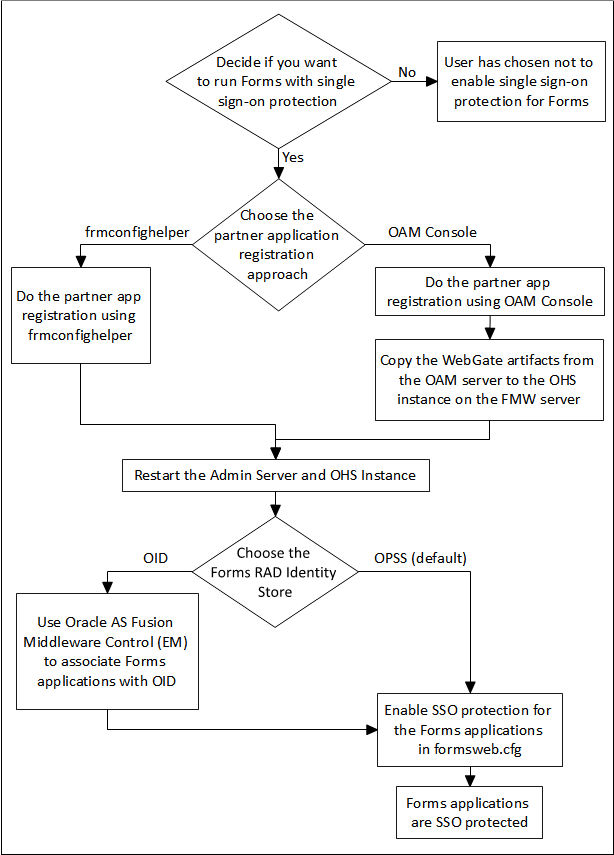Setup Process
Single Sign-On is not enabled out of the box for Forms applications.
The following step is required to enable Single Sign-On protection for Forms applications.
Enabling SSO for Forms Application after Configuring a Forms Services Weblogic Domain
Single sign-on (SSO) can be enabled for Forms Applications after setting up the Forms Services Weblogic Domain and after configuring a Web-tier instance in the Domain.
The following flowchart describes the steps to enable SSO for Forms application post installation.
Figure -31 Enabling SSO for Forms application post installation

Description of "Figure -31 Enabling SSO for Forms application post installation"
The steps depicted in the flowchart are described in the following table:
Table -27 Tasks to Enable Single Sign-On for Forms Application Post installation
| Tasks | Options | Description | Comments |
|---|---|---|---|
|
Prerequisite |
No |
Create a Web-tier (OHS) instance in the Weblogic Domain and enable Web-tier (OHS) to Forms managed server routing. |
|
|
Task 1: Make a decision if you want to enable single sign-on Protection for Forms applications. |
No |
User has opted to run Forms applications without single sign-on protection. |
|
|
Yes |
User has opted to run Forms with single sign-On server with Oracle Access Manager (OAM Server) as the authentication server. |
For detailed steps for installing OAM, see Oracle Fusion Middleware Installation Guide for Oracle Forms and Reports. |
|
|
Task2: Select the partner application registration approach. |
Use frmconfighelper script |
User has opted to use frmconfighelper script to register the web-tier instance as the partner application with Oracle Access Manager (OAM Server). |
For detailed steps, see Registering web-tier instance as OAM partner application and OAM policy configuration. |
|
Use OAM Admin Console |
User has opted to use OAM Console to do register the web-tier instance as the partner application with Oracle Access Manager (OAM Server). |
For detailed steps, see Registering web-tier instance as OAM partner application and OAM policy configuration. |
|
|
Task 3: Restart the Web-tier instance and Admin Server instance |
The Web-tier instance and the WLS Admin server have to be restarted to replicate WebGate configuration to the web-tier runtime instances. |
||
|
Task 4: Choose the Forms Identity Store type for storing Resource Access descriptors. |
Oracle Platform Security Services (OPSS) |
Oracle Platform Security Services (OPSS) is configured as the default Forms Identity Store, so no action is required. |
For detailed steps see Selecting Oracle Internet Directory or Oracle Platform Security as the Forms Identity Store. |
|
Oracle Internet Directory (OID) |
The user opted to use Oracle Internet Directory (OID) as the Forms Identity Store. |
For detailed steps on Forms Oracle Internet Directory (OID) association and enabling Oracle Internet Directory (OID) as the Forms Identity store see Configuring Forms J2EE application with Oracle Internet Directory. |
|
|
Task 5: Enable SSO for Forms applications in formsweb.cfg |
This task is mandatory. |
After having registered the Access client with the authentication server, the user must enable SSO for Forms applications. |
For detailed steps for enabling SSO for Forms applications in formsweb.cfg, see Protecting Forms applications with Single Sign-On. |